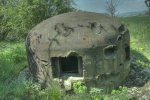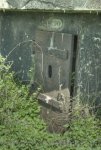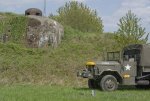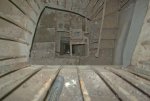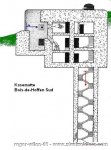Ryan,
please forgive me, but I have to dispute this a little

I agree to a lot of your points, but:
The Maginot Line is long and there surely were various tactics on the german side to deal with it.
In the Haguenau sector (Alsace) the tactic was definitly to attack it frontally to knock the large fortifications out. There was no "going around", because the combined Hochwald and the Schoenenbourgh fortresses (as well as Lembach and Four á Chaux in the west) were too strong and the weapons of these fortifications reached for quite long distances and could do considerable damage in that area if left intact. The Germans threw everything they had at the structures, including Stukas and He111, but the line held despite the fierce fighting and continous attacks. In fact, the Line in the Haguenau section was never defeated militarily, and the frontal lines stopped before it. There was no "going around". What brought an end to the affair was the truce in june 22nd 1940 and the order for the men in the fortresses, casemates and bunkers to surrender. Expecially the Schoenenbourgh and Hochwald complexes as well as the western ouvrages were very well equipped and could have continued to fight for quite some time.
I think that in the beginning of the conflict the french had a more than adequate mobile force behind the line, but it was reduced considerably during the conflict because the troops were needed to stop the advancing front towards Paris in the northwest. This is why the Vosges sector eventually fell. There was no use in keeping a strong force up there when the capital city of Paris was endangered, that is understandable in my terms. But anyhow, the Haguenau sector withstood despite the lack of mobile forces in the back, because of its sheer firepower and good coordination between the units, and the inability of the Germans to destroy the fortifications despite Stukas and heavy artillery.
The extreme destruction you see in some of my pictures occured when the Germans retreated towards the homeland 1944. They blew a lot of casemates or infantry bunkers up. One method was to seal the top floor of the bunker, fill it up with water and explode a large explosive device in it. That cracked even the thickest conrete walls, as you can see.
@ Larry:
the nearer the casemates are to a street or a settlement the more garbage, looting and graffiti you will see in the bunkers. You have to know where the real good ones are! This is why you need a offroad car for these trips, perfect for the deuce.
It is quite dangerous, by the way, to enter these structures. The stairways often lack of handrails, which invites for a 60ft free fall if one trips over the debris on the stairs. Then there can be very deep sewers and ducts in the floors. To enter the casemates usually means to make a loooong step over the diamond trench or ditch, which is about 20 feet deep, to reach a hinge on the armour door where one can put the foot on to enter the structure. Never step on anything in there (expecially covers or opening) and always look where you're going. I once almost fell into a hole which ended in a cistern, that surely can ruin your day... Since then I even walk around duct- or sewer covers on the open street or sidewalk.
Mark










